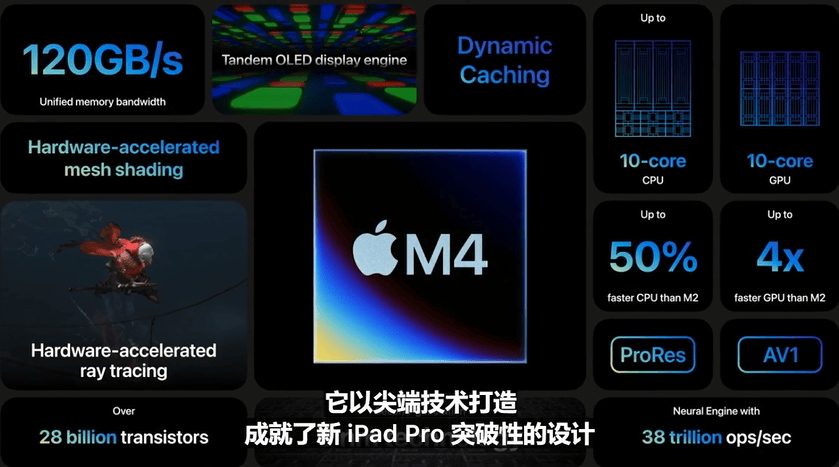Apple Unveils 2024 iPad Pro with M4 Chip
On May 7th, local time in the United States, Apple unveiled the 2024 edition of iPad Pro, featuring the debut of the M4 chip.
Reportedly, the Apple M4 adopts a second-generation 3nm process, equipped with the mainstream CPU+GPU+NPU combination in current AI PCs. The M4 chip features 4 large cores and 6 small cores CPUs, all equipped with Apple’s deep learning accelerator. It boasts a speed increase of about 50% compared to the previous generation chip, M2, on the iPad. Additionally, it houses a 10-core GPU, delivering approximately four times the performance of M2, supporting grid shading and ray tracing, ensuring smooth running of games like “Diablo Immortal” and rendering software like Octane.

Compared to the M3 chip released last October (currently used in Macs), the biggest enhancement of the M4 is its NPU. It is reported that the M4 incorporates a 16-core NPU, achieving a computation speed of 3.8 trillion operations per second. Its performance is more than double that of the base version of M3 and is 60 times that of the A11 chip (the first Apple chip equipped with NPU, used in iPhone 8, iPhone 8 Plus, and iPhone X).

Regarding power consumption, Tim Millet, Apple’s Vice President of Platform Architecture, stated: “The M4 provides performance similar to M2 with only half the power consumption, and compared to PC chips used in current ultrabooks, the M4 achieves the same performance with only one-fourth of the power consumption.” Apart from using the second-generation 3nm process (TSMC N3E), Apple has integrated graphite sheets into the casing and utilized copper for the logo to improve heat dissipation by approximately 20%.
Furthermore, to drive the iPad Pro’s OLED screen forming the XDR display, the M4 employs a new display engine to enhance the display’s precision, color accuracy, and brightness uniformity.
Author: Wang Xinhao
Editor: Zhang Xinyi
Art Editor: Maria
Producer: Lian Xiaodong